What is forced ventilation and how to properly equip it
Ventilation is the most important factor in the design of residential premises. For maintaining a healthy microclimate in a house or apartment, the supply ventilation is responsible - a system that provides replenishment of clean air.
Agree, it’s impossible to be in the stuffy for a long time. Lack of fresh air negatively affects the level of comfort and overall well-being of people. Therefore, it is important to take care of sufficient air exchange and to arrange effective supply ventilation.
We will tell you which type of fan installation is better to give preference to, and give step-by-step instructions for installing a compact candy bar.
The content of the article:
The principle of supply ventilation
Good air exchange in the living room is a must. It is far from always possible to organize effective ventilation of a house in a natural way. In such a situation, forced ventilation is considered one of the best options for residential premises.
Excessive sealing is a characteristic feature of modern apartments. Plastic windows are installed everywhere, which, unlike wooden windows, do not allow air masses at all. This also applies to entrance doors, which, when closed, block cold and dust, noise, and fresh air.
Partially solve the problem will help air conditioning with inflow function fresh air or window valve. However, they provide an influx into only one room.
Artificial, otherwise mechanical, supply ventilation is a system of means by which the necessary amount of fresh air is forced into the room. At the same time, the air flow is heated to a comfortable temperature and filtered to remove possible contaminants.
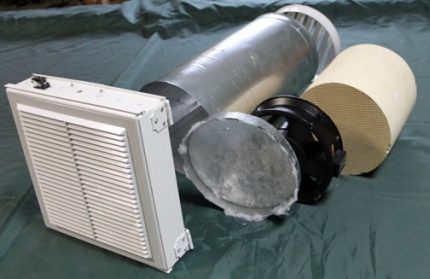
Supply ventilation systems
The supply fan is a necessary but insufficient element of the ventilation system with artificial motivation for the movement of air masses.
If such a device is installed in a wall or, for example, in a window, it will provide the necessary flow, but the quality of such air will be very far from what is desired. The flow not always supplied externally has an acceptable temperature.
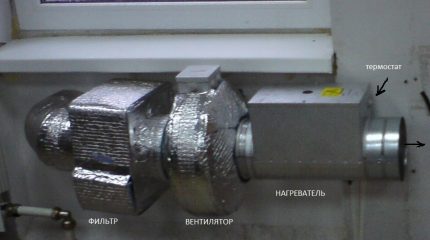
According to the regulations, the temperature of the air transported into the room must be at least 18 ° C. To form the required parameters, a heating device is needed.
In addition, it is necessary to protect the housing from dirt and dust, which can penetrate along with intensively incoming air masses. Therefore, such systems are necessarily equipped with filters.
Another important element is the automatic control system. Without such control, the device may overheat, resulting in breakdowns, fires or other troubles.
Finally, a noise suppression system, both penetrating from the street and published by the device, is also needed.
Thus, any ventilation should be equipped with the following elements:
- a fan;
- a heater;
- a filter;
- automatic control system;
- sound absorption system.
Of course, such a device can be made in various ways. For example, for large buildings, the ventilation system is implemented as a separate room - a ventilation chamber.
These are the so-called typesetting ventilation systems. For their creation, individual elements are selected and installed in the room reserved for this.
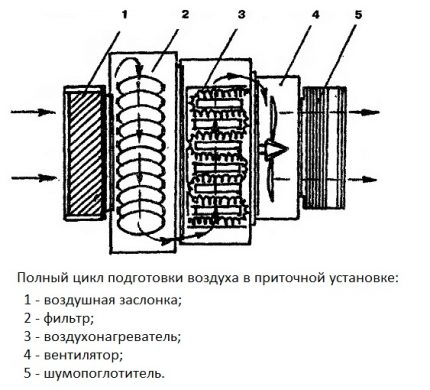
Types of installations for private homes
Perhaps, only an engineer with the appropriate qualifications will be able to assemble such a device independently, since design and installation, as well as the adjustment of the operation of such units requires special knowledge.
In addition, this is a rather bulky structure, which is not suitable for private households. For private housing construction, other ventilation options are designed - monoblock supply units and duct ventilation systems.
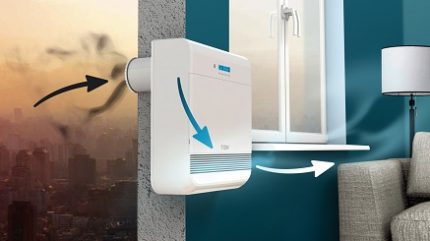
Type # 1 - monoblock version of equipment
For apartments, office structures, low-rise private houses, compact warehouses and even for small production workshops, air-handling units made in the form of a monoblock design are used.
This is a compact unit, in the housing of which all the necessary elements are already assembled and installed. Compared to the typesetting system, the supply monoblock takes up very little space.
Such devices have good sound insulation, they are installed on the balcony, and in the absence of such an opportunity - right in the room. Installation and adjustment of the operation of the supply units is extremely simplified, you just need to put it on and on.
The owners of such units note that with all the efforts of manufacturers to reduce the noise level, this problem has not yet been completely resolved.
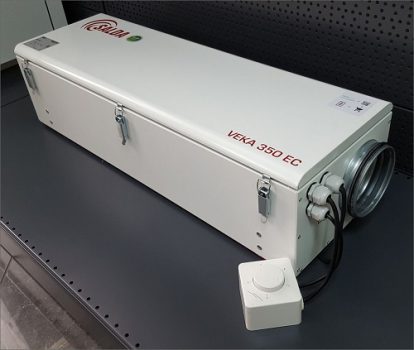
Sound effects may vary by model. In this regard, individual PUs emit as much noise as household air conditioning.
By the way, such a device with options for external air intake may well replace an individual PU. Such installations have not shown themselves particularly well in areas with a harsh climate.
When the outside temperature drops below 10 degrees below zero, PU with a recuperator (a device for heating the air) can be covered with a layer of ice.
It should be understood that an individual supply unit having a capacity of about 100 cubic meters. m per hour, it is designed to service only one room, and not the whole house or apartment.
Therefore, for normal ventilation of the entire living area, you will have to purchase as many individual air handling units as many rooms need ventilation.
On the one hand, this is convenient, since it eliminates the need for large-scale work on laying ventilation ducts throughout the house. On the other hand, the question arises of the cost of implementing such a ventilation system, because individual PUs are not cheap.
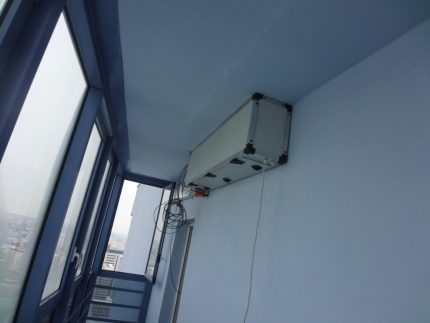
If the problem of room ventilation arose after the construction and decoration of the premises was completed, it is quite possible that the cost of several such installations will be less than the alteration of the entire building.
If ventilation ducts were designed at the construction stage, it will be cheaper and easier to implement a channel ventilation system.
Installation and assembly of a compact ventilation system can be done with your own hands without any problems. Consider the process of a ventilation device with a breather - a device that purifies and heats the air before it enters the room.
By similar technology mount a wall inlet valve. The ventilation device is suitable for an apartment or a private house.
Type # 2 - duct ventilation systems
The channel option is duct systemthat go through all the rooms. Supply units similar to monoblocks are located at the entrance to the system.
The air masses treated by the installation move through the channels and enter the room through the supply ventilation grilles.
Exhaust ventilation ducts and associated grilles are designed to remove exhaust air.
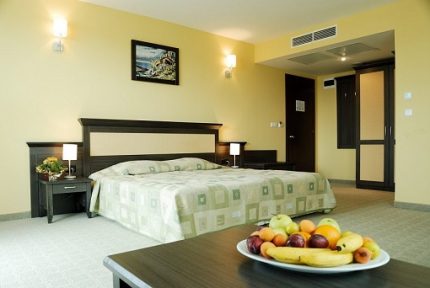
So for ventilation of the whole apartment or at home you need only one installation of the appropriate capacity.
Air ducts of the supply ventilation system are usually placed in the space under the ceiling, so as not to spoil the interior with unnecessary details. But ventilation grates need to be displayed directly on the ceiling or wall of the room.
Choosing the performance of channel installations:
- 200-350 cc m / hour - one and two bedroom apartments;
- 350-500 cc m / hour - Three-room apartments and large-sized residential apartments;
- 2000-3000 cubic meters / hour - offices or cottages.
Exact performance is calculated using special formulas.
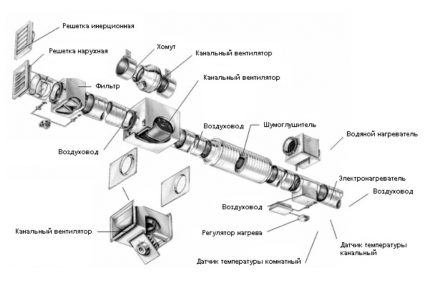
It should be understood that the maximum installed capacity declared by the manufacturer will not be realized in practice. Actual PU performance depends on the network resistance level.
To determine the real efficiency of the device, taking into account the characteristics of a particular channel system, you can use the graph of ventilation characteristics. It is usually contained in the product data sheet.
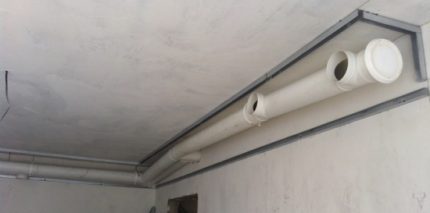
An important indicator in the calculation of ventilation systems is static pressure. The value depends on the total length of the ventilation ducts, as well as on the number of filters that are installed additionally.
For apartments, installations with a statistical pressure in the range of 400-500 Pa are used.
Components and parameters of ventilation installation
We will analyze in more detail the components of ventilation equipment, without which it will not be possible to create the optimal microclimate in the room. And consider their main characteristics and important parameters of the installation itself.
No. 1 - a device for heating air
As already mentioned, the air coming in from outside must be heated in the winter. For an apartment, a heater of 3-5 kW is usually enough.
For a house or a cottage, you will have to perform a number of special calculations. This takes into account the outside temperature, as well as the capacity of the installation itself.
It is important to correlate the load on the power supply network of an apartment or house with the real state of the network. If the load on the power supply is excessive, this can lead to a serious accident.
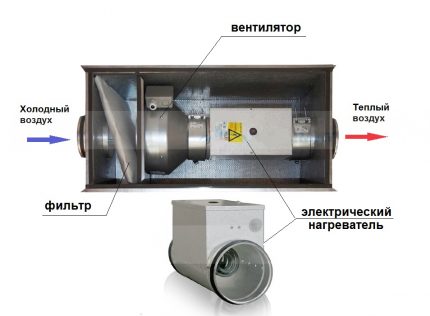
In such cases, some homeowners prefer to choose a supply unit with a less powerful heater.
This solution is fraught with the following problems: when severe colds occur, the air does not have time to warm up to the required temperature, and a cold stream will enter the rooms.
To prevent this phenomenon is not difficult - you just need to reduce the number of revolutions of the fan.
Air masses will arrive more slowly, but at the same time they will have time to warm up. Performing such a manual adjustment is extremely inconvenient.
If you have to buy PU with a low-power heater, you should make sure that the device is equipped with automatic regulation of the fan speed depending on the outdoor temperature.
No. 2 - acoustic power of equipment
When figuring out what duct ventilation is, the information that determines the noise effect of the operation of the device should be taken into account.
There are three indicators of acoustic power PU:
- at the entrance;
- at the exit;
- on the case.
The “input” noise characterizes the sound effect that the unit will emit at the beginning of the system. It usually does not affect home comfort too much. It is much more important to pay attention to the “output” noise, i.e. in places where ventilation grilles are installed.
If this indicator is too large, during installation, you will have to include an additional element in the system - a noise absorber. To obtain sufficient effect, the length of this element should be at least 90 cm.
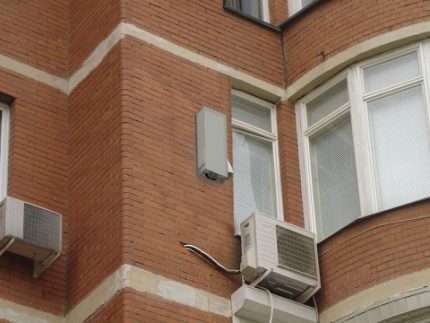
The noise “on the case” indicates an acoustic effect in the immediate vicinity of the air handling unit, which is installed and connected to the system and devices for absorbing noise. This indicator is not very important if the PU is installed outside the building.
But if this is not possible, and it is planned to place the device directly in the building, you should give preference to a device with a minimum value of acoustic power “on the case”.
In addition to the acoustic pressure, which is indicated in the technical documentation as LwA, manufacturers use the concept of sound pressure level (denoted by Lpa).
Do not confuse these two concepts, especially when comparing the characteristics of different models. It’s better to focus on LwA, since LpA data is usually slightly lower.
No. 3 - automatic control systems
Automation for the normal operation of the ventilation unit is a must. Even the simplest options are equipped with devices for automatically controlling the discharge air temperature and fan speed.
The device status and current settings are displayed on the display with the control panel.
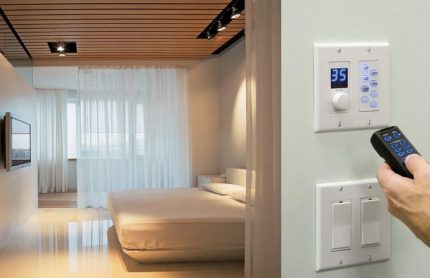
More “advanced” automation allows you to set settings for different periods of time. For example, you can reduce the temperature and the number of revolutions of the fan for the night period, when everyone is sleeping and the need for fresh air is not so high.
Separately, you can set the mode for daytime on weekdays when there is no one at home.
For convenient control of the ventilation unit, it is recommended to choose a device with the following characteristics:
- number of fan speeds not less than five;
- the presence of a real-time clock;
- saving and starting settings in case of emergency power outage;
- filter pollution control;
- the ability to remote control, for example, using a smartphone;
- message about the presence and nature of the malfunction.
An indication of the state of the filters is optional, but very desirable.In the absence of this option, the cleaning or change of filter elements is performed after a certain time recommended by the manufacturer.
But operating conditions are different, as a result, pollution can occur earlier or later than the specified time. Monitoring the condition of the filters will allow you to change them on time or extend the life of the filters.
Site selection and installation features
Before installing duct ventilation, a system design should be made. It should indicate the installation location of the PU itself, the location of the ducts, ventilation grilles, etc.
It is important to consider the direction of air flow. The place of receipt of fresh air masses should be residential premises, such as a living room, study, bedroom, etc.
As a result, unpleasant odors from the bathroom or kitchen will not get into the living rooms, but will be immediately removed through the exhaust grilles. Air flows can intersect with each other, reflected from the surface of furniture, etc.
It is better to think through these points in advance so that the trajectory of the air flow is as efficient as possible.
In winter, the temperature of heating the air coming from the street must be correlated with the amount of heat in the room. If the house is well heated, air heating can be left at a minimum level.
But if for some reason the power of the heating system is not enough, the forced air should be warmed up more.
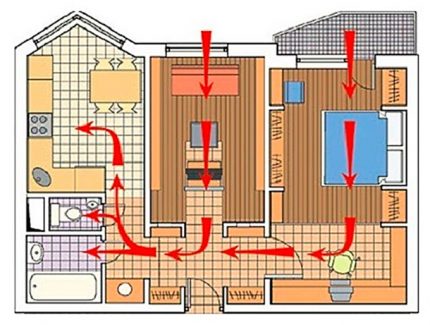
Choosing an air supply unit, you should decide on the purchase and installation of additional fine filters. Typically, such devices are equipped with filters of class G4, which are able to trap relatively large contaminants.
If there is a need or desire to get rid of fine dust, you will need another filter unit, for example, class F7. It is installed in the system after the supply installation.
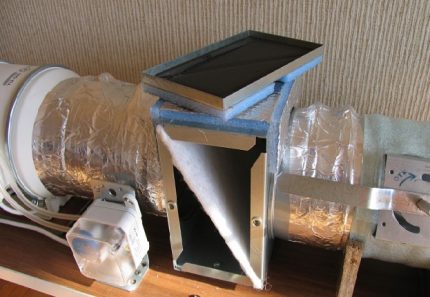
If the forced-air ventilation unit is not equipped with fine filters, then they are bought separately.
Even if the owners of the house for some reason refused to install such elements, it is still recommended to provide a place in the system in case this installation is needed in the future.
PU must be installed in such a way that it is available for regular maintenance and periodic repair.
Particular attention should be paid to the location of the inspection hatch through which the filters are replaced. The hatch should open freely, leaving enough space for manipulating the filter elements.
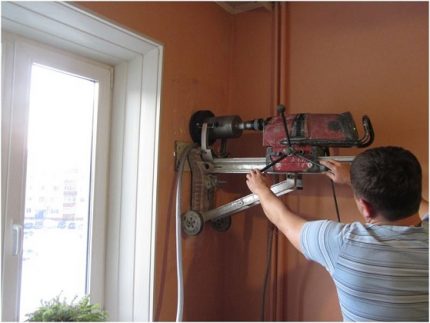
When installing PU, it is necessary to drill the outer wall. A puncher is usually not suitable for such work; work is carried out with a diamond drill with constant cooling with water.
In order not to damage the interior decoration, it is better to drill from the outside.
Conclusions and useful video on the topic
This video demonstrates the device and the principle of operation of the supply ventilation, as well as its difference from the natural ventilation of the premises:
Here you can see an overview of the “Eco-Freshness” air handling unit:
Fresh air ventilation is a great way to provide your home with fresh air and create a favorable microclimate in it. All the efforts and costs of creating such a system will fully pay off, since the health of all residents of the house depends on proper ventilation.
Share with your readers your experience in improving the efficiency of supply ventilation. Please leave comments on the article and ask your questions. The feedback form is located below.

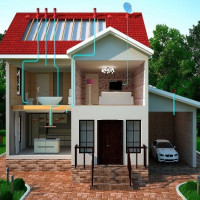 Ventilation in a private house: supply and exhaust systems + tips for arranging
Ventilation in a private house: supply and exhaust systems + tips for arranging 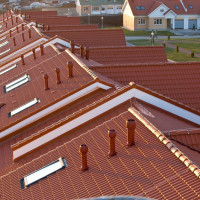 Soft tile roof ventilation: design and installation of soft roofs
Soft tile roof ventilation: design and installation of soft roofs 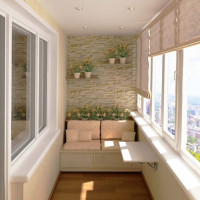 Exhaust ventilation on the balcony and loggia: options for organizing ventilation
Exhaust ventilation on the balcony and loggia: options for organizing ventilation 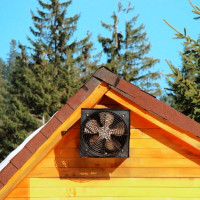 Ventilation in a wooden house: rules for providing a log house with an air exchange system
Ventilation in a wooden house: rules for providing a log house with an air exchange system 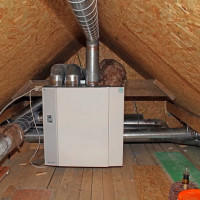 Ventilation in a two-story private house: options for organizing trouble-free air exchange
Ventilation in a two-story private house: options for organizing trouble-free air exchange 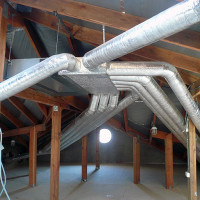 Cottage ventilation: options for organizing an air exchange system + device rules
Cottage ventilation: options for organizing an air exchange system + device rules  How much does it cost to connect gas to a private house: the price of organizing gas supply
How much does it cost to connect gas to a private house: the price of organizing gas supply  The best washing machines with dryer: model rating and customer tips
The best washing machines with dryer: model rating and customer tips  What is the color temperature of light and the nuances of choosing the temperature of the lamps to suit your needs
What is the color temperature of light and the nuances of choosing the temperature of the lamps to suit your needs  Replacement of a geyser in an apartment: replacement paperwork + basic norms and requirements
Replacement of a geyser in an apartment: replacement paperwork + basic norms and requirements
Fine! Everything is clear and obvious, it’s good that I came across this site and found so much information. On the Internet, unfortunately there is very little sensible information on ventilation systems.
Most of all I like the ventilation system of the ball as ventilation, here it really cools the air and cleans it, warms it up to room temperature. And besides, the design is pretty.
I read the article, a lot of information!
Thank. A very useful article, finally I got a complete understanding of what it is and for what, and how much I need and what I need to consider when choosing. Thanks again.